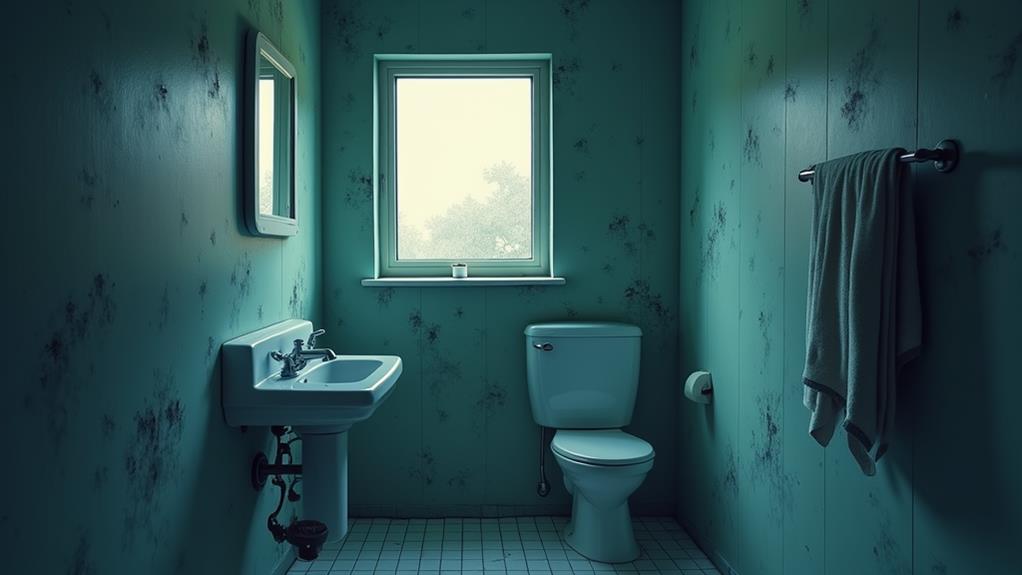Have you ever walked into your bathroom and been hit by a musty smell that just won’t go away? This common issue is usually a sign of underlying moisture problems, often stemming from inadequate ventilation or lingering dampness. Mold and mildew thrive in these moist conditions, setting up shop in hard-to-see spots like behind toilets or under sinks. While you might clean regularly, these hidden culprits can continue to emit a foul odor. But what can you do about it? Identifying the exact cause is the first step in tackling this pervasive problem, and the solution might be simpler than you think.
Poor Ventilation Issues
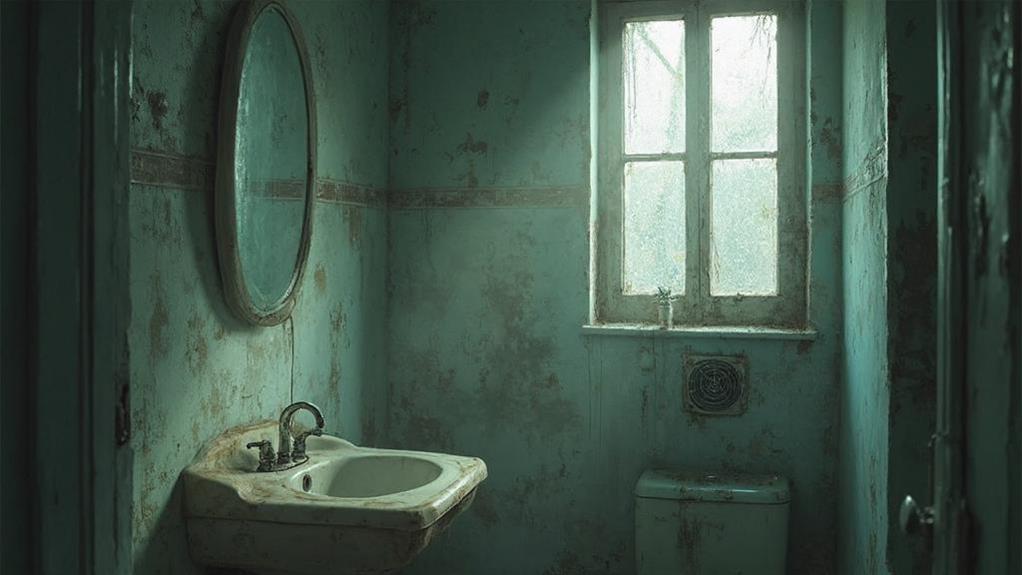
Often, a musty smell in your bathroom can be traced back to poor ventilation. You’ve probably noticed this especially after a hot shower when the air feels thick and sticky.
That’s because without proper air circulation, humidity hangs around like a clingy friend, making everything feel damp.
To tackle this, you’ll want to focus on improving humidity control. Start by checking if your bathroom fan is up to the task. It’s your first line of defense and should be running during your shower and for about 20 minutes after you finish.
This helps whisk away the humidity before it settles. If you don’t have a fan, think about installing one. It’s an investment that’ll save your nose and your walls in the long run.
Another trick is to crack open a window while you shower. This allows fresh air to circulate and old, moist air to escape.
It’s a simple fix but works wonders.
Mold and Mildew Growth
Building on the issue of poor ventilation, another significant concern in your bathroom is the growth of mold and mildew. These unwelcome guests thrive in damp environments, making your bathroom their favorite hotspot. To keep your space fresh and clean, tackling mold and mildew is a must.
You might wonder, “How do I keep these pesky intruders at bay?” Well, let’s explore some practical steps for mold prevention and mildew elimination. First off, always use your bathroom fan during and after showers to reduce humidity. Additionally, consider investing in a dehumidifier if moisture is a persistent issue.
Here’s a handy table to help you remember what to do:
| Action | Benefit | Frequency |
|---|---|---|
| Use exhaust fan | Reduces humidity, prevents mold | During/after shower |
| Clean regularly | Removes mold spores, prevents growth | Weekly |
| Apply anti-mold spray | Kills existing mold, prevents future growth | As needed |
Leaky Pipes and Fixtures
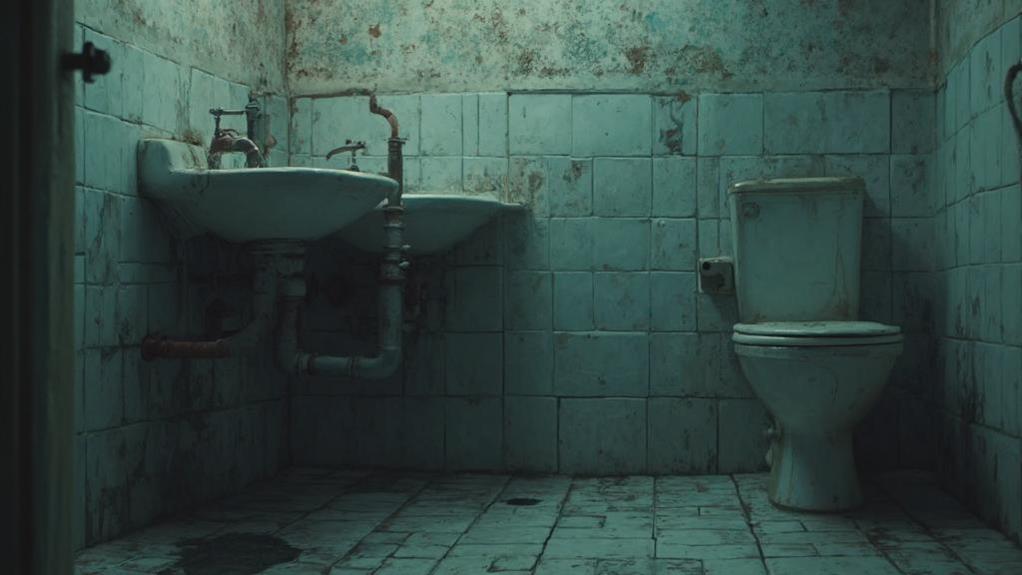
Beyond mold and mildew, another common issue in bathrooms is leaky pipes and fixtures. You mightn’t see the leak, but you’ll often smell it before it becomes visible! When water escapes from pipes or fixtures, it can seep into nooks you can’t easily reach, settling there and starting to stink.
It’s not just a nuisance; it can lead to bigger problems like water damage or even more mold.
So, what can you do about it? First, check around all your bathroom fixtures — think sinks, toilets, and tubs. If you spot any drips, don’t just ignore them! Small leaks can turn into big headaches. Make sure to tighten up any loose connections and consider replacing old fixtures that seem past their prime.
Another smart move is to add some pipe insulation. This helps control condensation and prevents moisture buildup, which can reduce the musty smell.
Regular fixture maintenance is key too. This doesn’t just mean fixing leaks; it involves cleaning out aerators or replacing washers. Keeping up with these tasks will help keep your bathroom fresh and less likely to develop those musty smells.
Old, Dirty Grout Lines
In addition to leaky pipes and fixtures, old, dirty grout lines can greatly contribute to a musty smell in your bathroom.
You mightn’t notice them at first, but those grout lines between your tiles can turn into a breeding ground for mold and mildew, which are big fans of damp environments.
Here’s what you can do:
- Grout Cleaning: Give those grout lines a good scrub. You’ll need a stiff-bristled brush and a suitable grout cleaner. Work it into the lines thoroughly to remove any mold and dirt buildup.
- Grout Sealing: Once the grout is clean and dry, apply a sealant. This acts like a protective coat, keeping water and moisture out, which helps prevent future mold growth.
- Regular Maintenance: Don’t just clean and forget. Schedule regular cleanings to keep everything fresh and tidy. It’s a bit like brushing your teeth; regular care prevents bigger issues down the road.
Accumulated Dirt and Debris
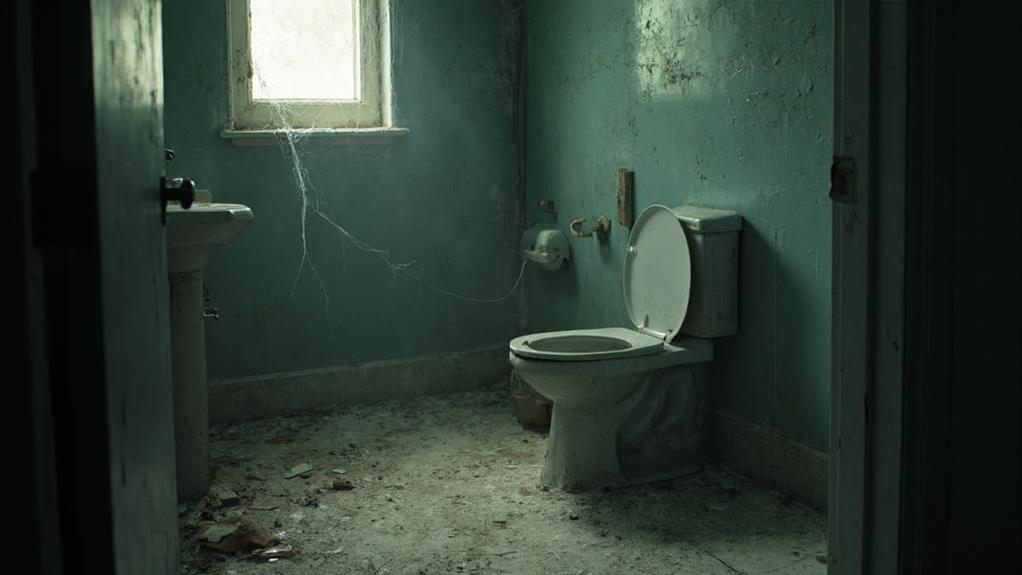
Accumulated dirt and debris in your bathroom not only looks unsightly but also contributes to the musty smell you’re combatting. When you skip regular bathroom cleaning, dust accumulation and surface maintenance fall by the wayside. If you’re noticing a stronger odor, it’s a sign to revamp your cleaning routines.
Start your battle against mustiness with some deep cleaning. Scrub all surfaces, paying special attention to corners where moisture and debris love to hang out. Regular hygiene practices, like wiping surfaces daily and managing humidity control, can greatly reduce odor buildup.
If your bathroom feels like a rainforest, maybe it’s time to look into ventilation solutions. Installing a fan or opening a window can help whisk away damp air and keep things fresh.
Don’t forget about air fresheners—they’re a quick fix but remember they’re just part of the solution. For lasting odor elimination, integrate effective hygiene practices into your daily life.
Make sure you’re hitting every nook and cranny during your clean-ups. Sometimes, the smallest spots can be the biggest culprits in harboring those pesky, musty smells.
Overused or Failing Drains
Many times, the persistent musty smell in your bathroom can be traced back to overused or failing drains. When you’re dealing with older plumbing or high usage areas, drain maintenance becomes essential for odor elimination.
Let’s break down what you can do:
- Regular Cleaning: Don’t wait for the smells to remind you! Clean your drains monthly to keep them fresh. Use a mixture of baking soda and vinegar to fizz away the gunk.
- Check for Damage: Cracks or loose fittings can let moisture seep out and odors seep in. Take a flashlight, have a look under the sink, and if you spot anything suspicious, it might be time to call a pro.
- Update Fixtures: If your drains are older than your favorite sitcom reruns, consider updating them. Newer designs are more efficient and better at keeping bad odors at bay.
Stagnant Water Problems
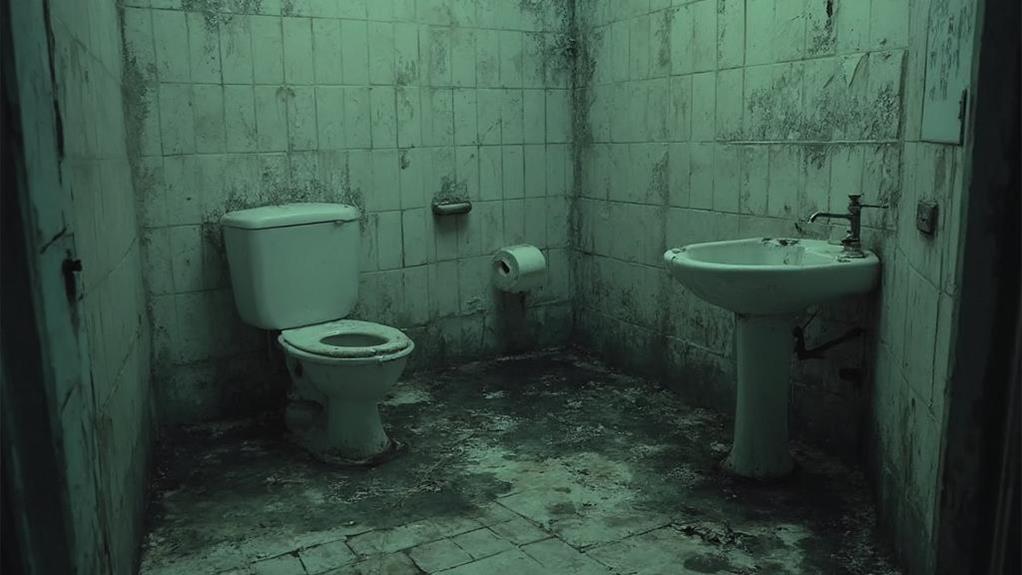
If you’ve noticed that your bathroom smells a bit off, it could be because of stagnant water lingering around.
Leaky faucets not only waste water but they also create the perfect damp spot for mold to start growing.
Plus, if your bathroom isn’t ventilated properly, the moisture can’t escape, which just makes everything worse!
Leaky Faucets Impact
Leaky faucets not only waste water but also contribute to stagnant water problems that can cause your bathroom to smell musty. When water from your faucet drips continuously, it creates the perfect environment for mold and mildew to thrive. These unwelcome guests are major culprits behind that musty odor you’re noticing.
Here’s how you can tackle this issue:
- Regular Inspections: Check your faucets and their connections regularly for any signs of leakage. Early detection can save you from bigger repair bills and musty smells.
- Prompt Repairs: If you spot a leak, don’t wait! Fixing a leaky faucet promptly is essential for effective moisture control in your bathroom.
- Consider Upgrades: If your faucets are old and frequently leaking, it might be time to replace them with newer, more efficient models designed to prevent leakage.
Faucet maintenance isn’t just about keeping things looking good; it’s also about preventing moisture buildup that leads to that musty smell.
By staying on top of these tasks, you’ll not only preserve water but also maintain a fresher, more pleasant bathroom environment.
Poor Ventilation Effects
Beyond addressing leaky faucets, another significant factor in combating musty odors in your bathroom involves improving ventilation. When you’ve got poor air circulation, humidity tends to build up. This not only makes your bathroom feel stuffier but also allows stagnant water issues to arise. You’re basically inviting musty smells to settle in!
Improving ventilation is essential. Opening a window or installing an exhaust fan can do wonders for air circulation and humidity control. You’ll feel the difference almost immediately. It’s like giving your bathroom a refreshing change!
Here’s a quick look at how better ventilation impacts your space:
| Benefit | Description |
|---|---|
| Reduced Humidity | Less water vapor hanging around. |
| Fresher Air | Stale, musty air gets pushed out. |
| Drier Surfaces | Helps prevent water from lingering. |
| Better Health | Reduces potential for allergens. |
Mold Growth Risks
After improving ventilation in your bathroom, it’s crucial to address stagnant water issues that contribute to mold growth.
Stagnant water creates a cozy home for mold, which loves nothing more than a damp, dark spot to flourish. This isn’t just a minor annoyance—it’s a serious concern that can impact your health.
Mold exposure can lead to various health risks, including allergies, respiratory problems, and more severe conditions if you’re particularly sensitive or have pre-existing health issues.
Here’s what you can do to keep mold at bay:
- Regularly Check for Leaks: Confirm all plumbing fixtures are in tip-top shape. A dripping faucet isn’t just annoying; it’s a mold party invitation!
- Dry Wet Areas Immediately: After a bath or shower, make certain to wipe down the surfaces. Don’t let water hang around!
- Use a Dehumidifier: This can be a game-changer in reducing moisture levels, making it less inviting for mold.

